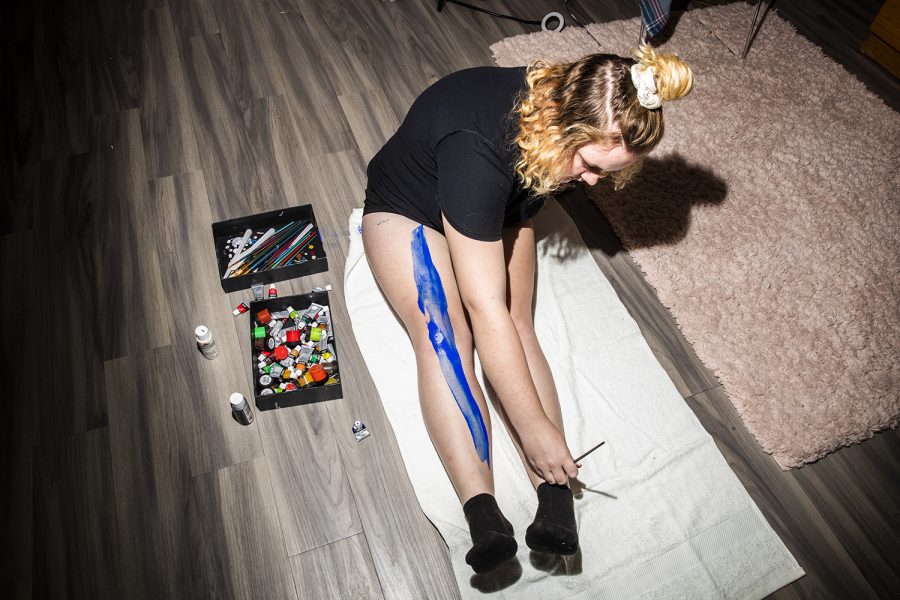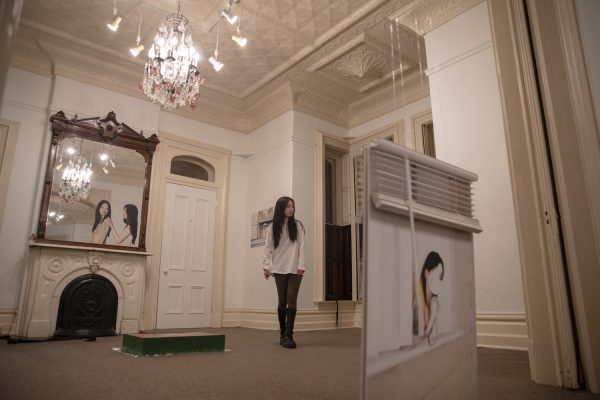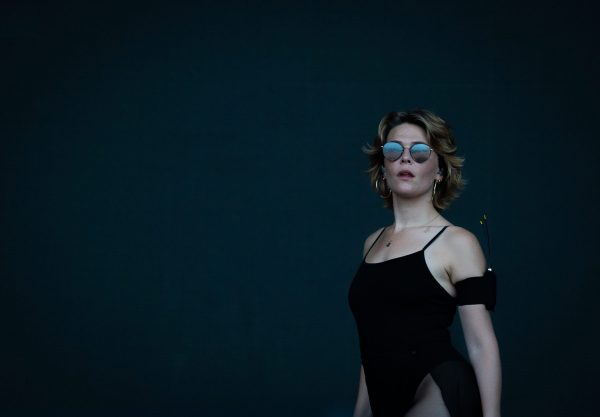The artistic journey to a healthy mind: how art therapy helped me cope
There are multiple different types of art therapy, including painting, music, and dance. One DI arts reporter uses body painting as a means of turning herself — and her inner feelings — into a work of art.
UI freshman Ashley Dawson paints herself in Burge Residence Hall on Tuesday, September 24, 2019. Dawson started painting her body in order to develop a coping mechanism for her anxiety.
September 26, 2019
Dealing with depression is nothing new to me. Although I was officially diagnosed in 2013, I have been struggling with the thoughts, feelings, and daily challenges it presents me with for much longer.
Soon after my diagnosis, I came to the conclusion that my coping mechanisms for dealing with my depression were extremely unhealthy for both my physical and mental well-being. I began going to therapy in 2014, but even after several sessions, it seemed to me that nothing was improving.
Three years later, I began the search for new ways to cope. One evening, as I sat in my bed scrolling through Netflix, I came across a TV show titled Skin Wars. I binged all of the episodes available. Following this, I asked my artistic friend to paint on my back like the artists did on the show.
As she painted a starry sky above a dark skyline on me, I felt my body begin to relax under the feeling of the brush. It felt like fingers tracing the lines of my back, spreading a cool sense of calm across my mind. After 10 minutes, she was done. From that moment on, I was hooked.
I invested in my own paint brushes, bought acrylic paint, and began to transform myself into my own work of art.
One of the best things about body painting to me is the mindset of turning myself into an artistic masterpiece, while also getting the chance to express how I feel using colors, strokes, and the overall design of what I paint.
If I am in a poor mental state, I’m more likely to use dark colors and long strokes, slowly dragging the brushes against my skin, spreading colors to mirror my thoughts. On the contrary, if I’m in a healthy mental state, my designs are bright and vibrant, quickly painted and splattered across the canvas that is my body.
My paintings often reflect my moods. When I am feeling confused, I’ll paint abstractly. These paintings can turn out as simple spreads of lines and color, or may become a mess of colors or sprinkles. When I am feeling spaced-out, I’ll paint the galaxy, planets, or stars.
When painting, I prefer to sit in a dark room with a single source of light such as a lamp. I listen to indie music, and I begin to feel my body and my mind relax as the painting grows to cover more skin.
As someone with poor mental health, simple daily tasks such as studying, waking up on time, going to class, and proper hygiene easily become overwhelming and more than difficult to accomplish. However, I’ve learned there are ways to cope with these mental issues in order to make such tasks less of a hassle.
There are plenty of opportunities offered to students to get involved on-campus, seek help from university counselors, or if one prefers, seek off-campus counseling. Unfortunately, from my own experience, I’ve discovered that actively seeking these resources can be just as difficult to do as normal daily tasks, if not more.
A majority of quick-start hobbies have some creative elements, including painting, drawing, music, or dance. While in the process of creating a habit out of body painting, it seemed to be impossible to do it every day, but once I noticed how much my mood shifted from negative to positive during these sessions, it became therapeutic and much easier to keep up with.
While one of the most well-known art-therapy techniques is painting, there are a multitude of ways to make this hobby more your own, such as body painting.
I prefer to use non-toxic acrylic paint since it is cheaper than professional body paint, and washing it off is as easy as painting it on.
There are many other reasons for somebody to take advantage of art therapy or artistic coping skills aside from poor mental health. For nine-year-old Emme Oberbreckling, art therapy aided her recovery from an unnamed kidney disease. Oberbreckling created “Transplant Love” during her art therapy session at the UI Stead Family Children’s Hospital, under the supervision of art therapist Kamila Agi-Mejias.
Art therapy was not Emme’s first encounter with painting, however.
“Emme has always enjoyed art, and art therapy was good for her to spend time getting out of herself, especially during dialysis,” Emme’s mother Marcy Oberbreckling said.
Emme’s “Transplant Love” has gone on to win the annual calendar contest sponsored by the American Kidney Fund.
“When we found out she had won the contest, we thought the prize was just bragging rights, but her artwork will be on the cover of the American Kidney Fund’s 2020 calendar. We are also taking a trip to Washington D.C. in October for the national Hope Affair fundraising gala,” Oberbreckling said.
“Transplant Love” was created using a mixture of different paints.
“It was mostly tempera, but there was some acrylic in there as well, like in the gold metallic paint we used,’’ Agi-Mejias said.
Aside from painting, music therapy is also a growing form of art therapy. Music therapy is practiced in a multitude of ways, including improvising on instruments – whether it’s through a guitar, piano, ukulele, vocals, or others – listening to music to change one’s heart rate, and demanding attention from the brain.
According to Children’s Hospital music therapist Kirsten Nelson, music has a direct effect on one’s mood due to the process that the brain goes through to gauge music.
“I use this quality of music to assist people with expressing their sadness or to pick them up when they’re feeling depressed,” Nelson said.
General art therapy can range from painting a piece and analyzing it to dance therapy. There are a multitude of forms of art therapy in the world for anyone to try.
Whether one considers themselves artistic or not, art therapy may have some type of effect. If one cannot find a kind of art therapy that they want to try, they can always do it themselves. Therapy does not always need to be with a professional therapist. Attempting to try out some artistic hobbies can morph into the type of self-help that has kept not only myself, but others as well in a healthy state of mind.
















